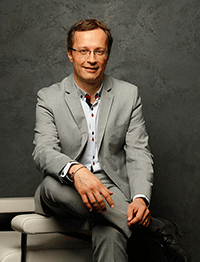AI is challenging the way we teach: it’s our job to adapt!
Published on 06/5/2023
Thematics :
AI is challenging the way we teach: it’s our job to adapt!
Published on 06/5/2023
Generative AI, such as ChatGPT, Google Bard or Midjourney, are shaking up our relationship to information and creativity… and, by extension, to learning. In this article we put the spotlight on ChatGPT and the impact it is having on higher education with Alain Goudey, Associate Dean for Digital at NEOMA Business School.
ChatGPT (Generative Pre-trained Transformer) is a generative artificial intelligence that interacts with users in the form of a chatbot. When you put a question to ChatGPT, it is able to construct an answer based on all the data the AI has assimilated during its training (“public” internet data up to November 2021). We are not talking here about a Google search result, but a relatively well-researched and comprehensively-written text. It is a revolution, and it’s moving very fast. Alain Goudey, Associate Dean for Digital at NEOMA, explains how “training and educational methods will have to evolve very quickly to factor in this radical transformation of society in the age of AI.”

“The Future of Jobs report published by the World Economic Forum forecasts that 69 million jobs will be created but 83 million destroyed by 2027. A March 2023 study by Goldman Sachs found that a quarter of today’s work tasks performed by humans could be AI-automated in the US and Europe.
As a higher education institution, we need to train our students so they become fluent in this type of technology. The fact is that it’s not generative AI that will take over certain types of job: it’s people who have a sound grasp of the technology that will replace them.
AI will be built into all the tech tools we use on a regular basis, such as Office 365, mobile phones and search engines. Even if we wanted to, it wouldn’t be possible technically to outlaw ChatGPT.”
“Like all technologies, ChatGPT is a means to an end, not an end in itself! As teachers, we have to make sure that our students are aware of its limitations and know how to use it properly.
Text generated by ChatGPT doesn’t have any meaning for the machine; it’s a statistically significant response to the question it has been asked. This means we shouldn’t simply copy and paste the results. The text should serve as a starting point for weighing up a more detailed, more comprehensive answer so you can progress your thinking.
ChatGPT itself doesn’t ‘think’”. It can help a student’s learning process but can’t stand in for a professor’s teaching or a student’s personal exploration.
In addition, generative AI is based on a dataset, which is unique to each model. This means the language of the training corpus, and behind this language there is the culture. Behind the culture, there is the worldview. There are always biases in the culture, and it’s important for students to be aware of them. These biases will depend on the tools (and model) used: detailed knowledge is absolutely essential!
AI is growing all the time, and new models are yet to emerge. It’s important that all our students acquire the flexibility needed to switch from one AI to another. And they’ll also have to develop skills for writing instructions (or prompt engineering) – an area we’re already helping them with.”

Close up a of sleek humanoid robot writing with a pen on paper, chatGPT concept, Generative AI
You can see straight away that AI that generates content for you is going to interest students, and there is a glut of examples in the media. But Goudey argues that there is little point in being afraid; quite the opposite, in fact – AI is something we have to leverage.
“Integrating ChatGPT and AI into higher education means we have the opportunity to think over and upgrade the process for assessing students.
ChatGPT has the potential to transform education and make it fairer and more productive. How? By focusing on personalised assessments, on-going support, high-quality feedback and a smaller teaching workload.
The time saved means there’s more human interaction, which is beneficial for teachers and students alike. As a professor, I think that the combination of humans and AI can radically transform education! But standalone AI won’t be more efficient!
Developing soft skills, critical analysis and the capacity to learn has always been NEOMA’s guiding principle. And it has never been so important as it is now: in the age of artificial intelligence, here at NEOMA we cultivate human intelligence. And it makes all the difference.”

